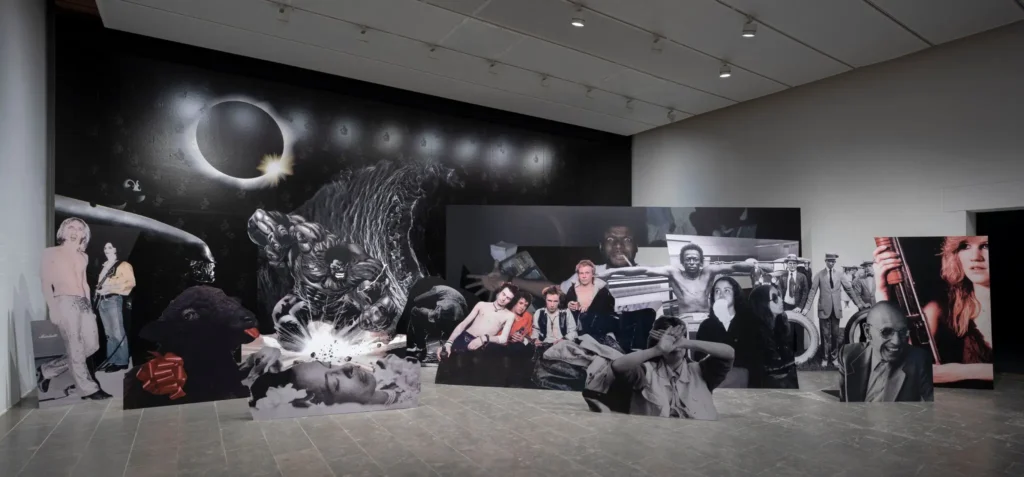
Alex Greenberger was not getting the Arthur Jafa love message, on account of all the death. In his ARTnews review of Jafa’s shows, he doesn’t see a point to the en-Blackening and looping of violent scenes from Taxi Driver at Gladstone; nor to Jafa’s concatenation at 52 Walker of Cady Noland-esque image/sculptures “seemingly at random,” fronted by an image of Noland herself:
Those borrowed shots continue outside Picture Unit in the form of an assembly of cutouts, some of which have holes bore through them. These sculptures allude to similar ones by Cady Noland of Patty Hearst (from her Symbionese Liberation Army days). Noland’s portrait, featuring her hands in front of her face, is here appropriated by Jafa. He places her beside an image from 1970 of artist Adrian Piper, performing with a sock stuffed into her mouth. What do Piper and Noland have to do with, say, a black lamb with a red ribbon around its neck or a group of rock musicians? Nothing, except that the images all ended up in Jafa’s archive, as have many others that he has arranged, seemingly at random, in the form of binders.
Greenberger’s experience feels a little wild, ngl, because it does seem closed to what have been central tenets of Jafa’s visual art practice from the jump: his decades-long accumulation into binders of photos, images, clippings, and ephemera that resonate in some way with the lived Black experience and as documentation of a generative Black aesthetic language; the centrality of music to Black—and American and world—culture; and the fundamental decentering of white validation and judgment. Everyone gets to listen in, Jafa has repeatedly said, but he is addressing Black people.

Recognizing some of the images in Large Array II doesn’t “solve” it like a puzzle. Neither does recognizing that it’s a reconfiguration of an installation he showed in 2020 at the Louisiana museum called, unsurprisingly, Large Array, which was reconfigured again at Luma Arles in 2022. But repetition and recognition does reveal more of the resonant structure in Jafa’s visual/spatial composition and help realize more clearly that, as Jafa said in 2017, “we were in the presence of a thing that had a complicated relationship to the culture”:

From left to right: Don, one of the Famous Monsters of Filmland comic characters Jafa obsessed over—and identified with—as a kid, and one of the poppingest objects collectors could buy when all the video editions went to museums; don’t look now, but another monster, LeRage, is right behind you;
Black lamb with a second-prize ribbon around its neck from the cover of Funkadelic’s Greatest Hits (1975);
Sid Vicious and the Sex Pistols in between Stevie Nicks with a didgeridoo[?] and Iggy Pop and a Stooge;
In Cultured, Danielle Jackson says there’s a 1964 photo of police investigating the car of Chaney, Goodman, and Schwerner which, by process of elimination, must be the gigantic panel looming over everything else? No, that can’t be, that is Larry Levan at Paradise Garage;
Billie Holiday in her coffin;
Jafa selfie wearing a latex corset with a rolling rack behind him;
Miles Davis chilling, crucified-like, in a boxing ring, notes Danielle Jackson, who also makes important observations about Davis’s domestic violence and the show’s overall vibe of male “genius” combined with women “on the defensive”; Jafa’s identification with Davis, the binders, and Jafa’s anointing as an object-making visual artist all coalesce in his conversation with Theaster Gates, which ran in Tank Magazine 96 in 2023, it’s problematic faves all the way down;
Klaus Baum’s 1992 photo of Cady Noland at Documenta, which Wikipedia dates as 2006, which led me to find almost 10yo website cadynoland.com [belated thanks for the links!];
Documentation photo of Adrian Piper’s Catalysis (1970), in public with a towel stuffed in her mouth, a series about the edges of the self and society and art which she discussed at length with Lucy Lippard, and an image which echoes Noland’s sculpture Oozewald, which has a US flag stuck in Lee Harvey Oswald’s mouth;
Tourmaline portrait with a constellation of Noland-style punctures;
and manic grin Michel Foucault.

With track changes on, one thing that stays the same is Noland in the front row, and what has entered the Large Array II at 52 Walker is Tourmaline, and Jafa himself. The “fetish”-like sculptures Jafa showed at Gladstone 64th Street in 2021, alongside a photo of an unidentified Black penis have never looked more Noland-esque—or more autobiographical.
I stopped writing this post to watch Jafa’s entire interview for the Louisiana show, and it feels clearer than ever that we are watching an artist who stares harder at disturbing things, and who keeps placing and re-placing the images he notices next to each other until he can figure out why he’s drawn to them. In the process, he keeps finding out things about the culture and himself. Nauseating feels like a valid response, but I, at least, am not disappointed.
Arthur Jafa’s Revisionist ‘Taxi Driver’ is a Nauseating Dissapointment [artnews]
Arthur Jafa: ***** runs through May 4, 2024 [gladstonegallery]
BLACK POWER TOOL AND DIE TRYNIG runs through June 01, 2024 [52walker]
